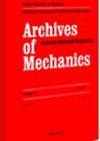Impact of a discretization scheme on an autoignition time in LES of a reacting droplet-laden mixing layer
IF 1.2
4区 工程技术
Q3 MATERIALS SCIENCE, CHARACTERIZATION & TESTING
引用次数: 1
Abstract
We analyse an autoignition process in a two-phase flow in a temporally evolving mixing layer formed between streams of a cold liquid fuel (heptane at 300 K) and a hot oxidizer (air at 1000 K) flowing in opposite directions. We focus on the influence of a discretization method on the prediction of the autoignition time and evolution of the flame in its early development phase. We use a high-order code based on the 6th order compact difference method for the Navier–Stokes and continuity equations combined with the 2nd order Total Variation Diminishing (TVD) and 5th order Weighted Essentially Non-Oscillatory (WENO) schemes applied for the discretization of the advection terms in the scalar transport equations. The obtained results show that the autoignition time is more dependent on the discretization method than on the flow initial conditions, i.e., the Reynolds number and the initial turbulence intensity. In terms of mean values, the autoignition occurs approximately 15% earlier when the TVD scheme is used. In this case, the ignition phase characterizes a sharp peak in the temporal evolution of the maximum temperature. The observed differences are attributed to a more dissipative character of the TVD scheme. Its usage leads to a higher mean level of the fuel in the gaseous form and a smoother distribution of species resulting in a lower level of the scalar dissipation rate, which facilitates the autoignition process.离散化方案对反应液滴混合层LES中自燃时间的影响
我们分析了两相流中的自燃过程,该两相流在冷液体燃料(300K下的庚烷)和热氧化剂(1000K下的空气)沿相反方向流动的流之间形成的随时间演变的混合层中。我们重点研究了离散化方法对预测自燃时间和火焰早期发展阶段演变的影响。我们对Navier–Stokes和连续性方程使用了基于六阶紧致差分法的高阶代码,结合了用于标量输运方程中平流项离散化的二阶总变差递减(TVD)和五阶加权本质非振荡(WENO)格式。结果表明,自燃时间更多地取决于离散化方法,而不是流动初始条件,即雷诺数和初始湍流强度。就平均值而言,当使用TVD方案时,自燃提前约15%发生。在这种情况下,点火阶段的特征是在最高温度的时间演变中出现一个尖锐的峰值。观察到的差异归因于TVD方案的耗散特性。它的使用导致气体形式的燃料的平均水平更高,物种的分布更平滑,导致标量耗散率的水平更低,这有助于自燃过程。
本文章由计算机程序翻译,如有差异,请以英文原文为准。
求助全文
约1分钟内获得全文
求助全文
来源期刊

Archives of Mechanics
工程技术-材料科学:表征与测试
CiteScore
1.40
自引率
12.50%
发文量
0
审稿时长
>12 weeks
期刊介绍:
Archives of Mechanics provides a forum for original research on mechanics of solids, fluids and discrete systems, including the development of mathematical methods for solving mechanical problems. The journal encompasses all aspects of the field, with the emphasis placed on:
-mechanics of materials: elasticity, plasticity, time-dependent phenomena, phase transformation, damage, fracture; physical and experimental foundations, micromechanics, thermodynamics, instabilities;
-methods and problems in continuum mechanics: general theory and novel applications, thermomechanics, structural analysis, porous media, contact problems;
-dynamics of material systems;
-fluid flows and interactions with solids.
Papers published in the Archives should contain original contributions dealing with theoretical, experimental, or numerical aspects of mechanical problems listed above.
The journal publishes also current announcements and information about important scientific events of possible interest to its readers, like conferences, congresses, symposia, work-shops, courses, etc.
Occasionally, special issues of the journal may be devoted to publication of all or selected papers presented at international conferences or other scientific meetings. However, all papers intended for such an issue are subjected to the usual reviewing and acceptance procedure.
 求助内容:
求助内容: 应助结果提醒方式:
应助结果提醒方式:


